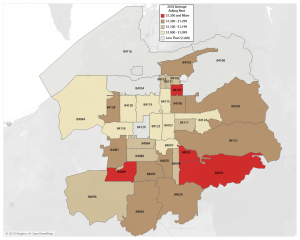Blog Post
Insight: Rising Rents and Changing Preferences Define Salt Lake’s Rental Apartment Market
By: DJ Benway
Apartment rental rates in Salt Lake County are nearly double from where they were 18 years ago. In 2000, the average rent for an apartment in Salt Lake County was $647 per month. By 2018, the average rent increased to $1,153 per month (Figure 1). Robust economic and demographic growth, increased demand, and shifting housing preferences have led to exceptional demand for apartments in the region. Despite the record number of apartment units developed since 2014—over 27,000 units—vacancy rates remain low and rental rates continue to increase.
Figure 1: Average Rent for Apartment Units in Salt Lake County, 2000 – 2018

Source: CBRE, Inc. and CoStar Group, Inc.
Many of the new apartment communities target the high-end apartment market and have some of the highest average rents in the county. Surprisingly strong demand for luxury apartment rentals near the urban and employment centers has focused growth toward high-end rental communities. Many of the county’s most expensive ZIP codes are located near downtown Salt Lake City, or in the southern part of Salt Lake County near Point of the Mountain, an epicenter of Utah’s booming tech sector (Figure 2). The demand for luxury units near employment centers is driving up rental rates overall, adding further pressure to affordability.
Figure 2: Average Rent for Apartment Units in Salt Lake County by ZIP Code, 2018

Source: CoStar Group, Inc
As population and economic growth persist, apartments will be an increasingly desirable housing option throughout the metropolitan area. Increasing demand for modern apartments offering upscale amenities in central locations will drive the market for new units. A competitive market, increasing costs of construction, and demand for high-end rental units will continue to put upward pressure on rental rates, placing increased pressure on cost-burdened households with lower incomes.
There is little relief in sight for renters. Rental rate increases are likely to continue to outpace income growth, further eroding housing affordability. These conditions present a serious challenge for renters, policy makers, and non-profit housing advocates.
For more detail, view the Gardner Institute report: The Salt Lake Apartment Market: An Analysis of Apartment Rental Rates in the Greater Salt Lake Region.
DJ Benway is a research analyst at the Kem C. Gardner Policy Institute.






